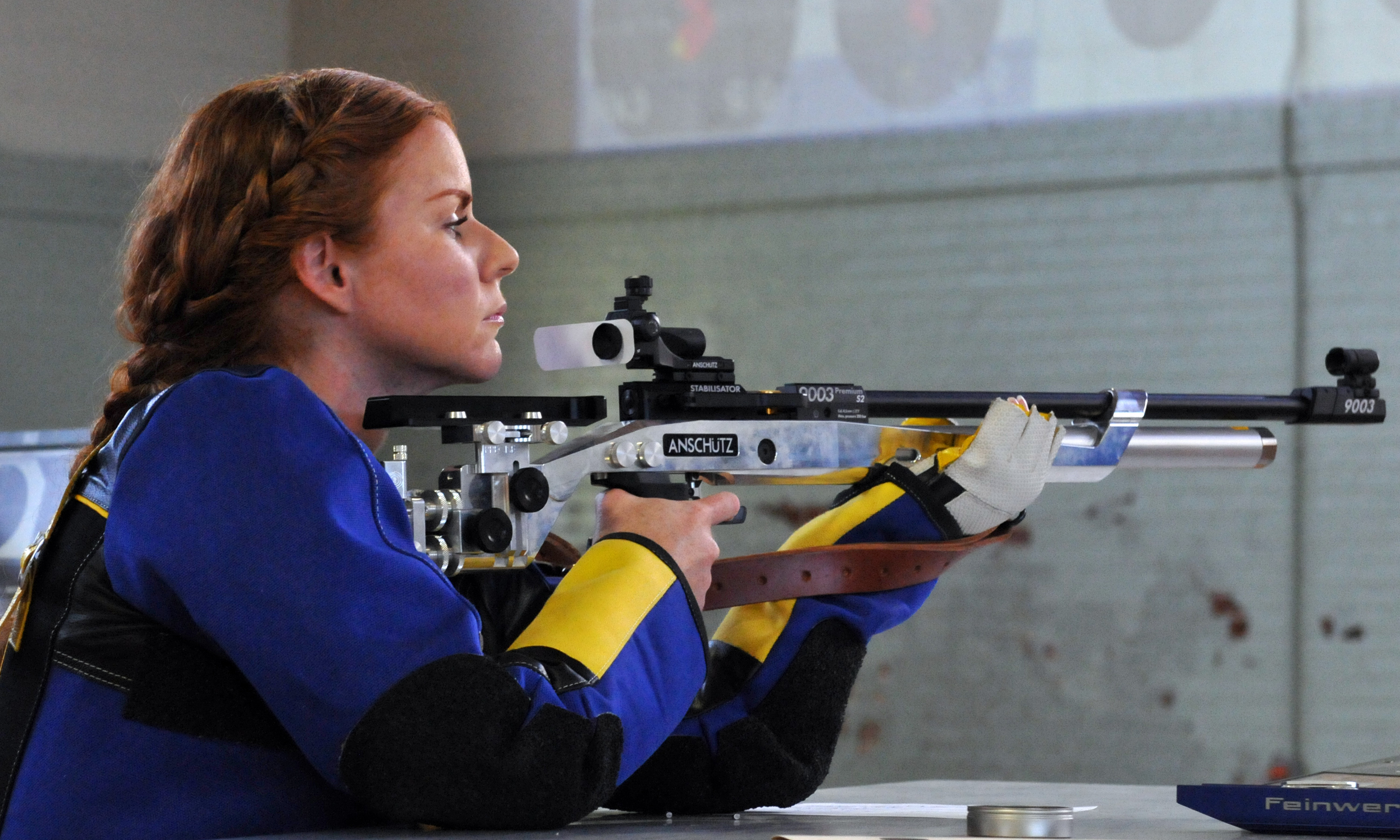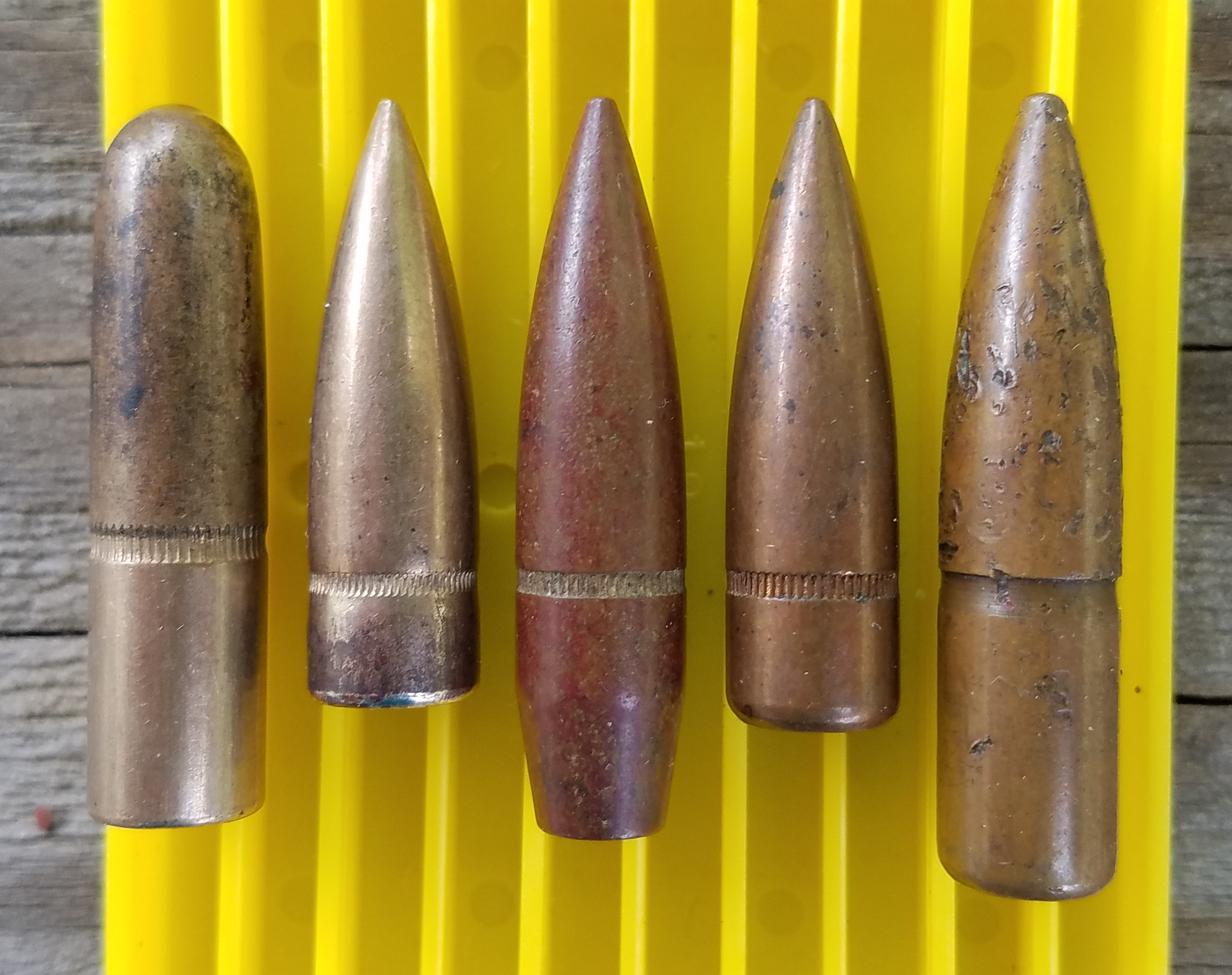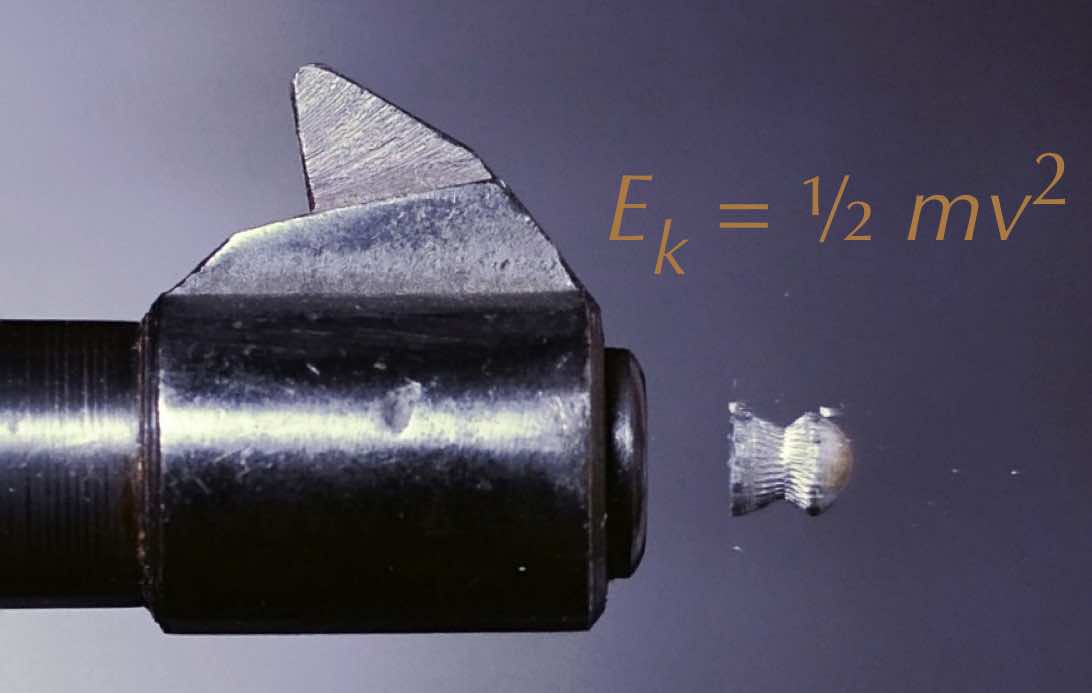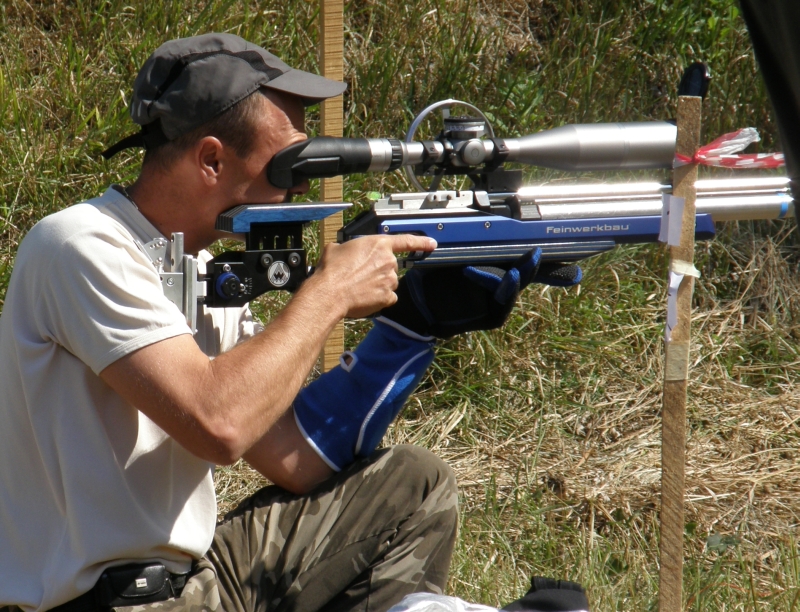|
.177 Caliber
.177 caliber or 4.5 mm caliber is the smallest diameter of pellets and BB shots widely used in air guns, and is the only caliber generally accepted for formal target competition. It is also sometimes used for hunting small game, like fowl. It is also used in field target competitions, where it competes with .20 caliber (5 mm) and .22 caliber (5.6 mm) rifles. Steel BBs are typically slightly smaller than lead BBs at diameter, although the bore diameter of the barrel are the same. Some air guns are designed to accept .177 pellets, .177 lead shot, or .175 steel BBs interchangeably. Relationship between caliber and trajectory If two guns fire pellets of different weights, the gun firing the lighter pellet must fire it at a higher velocity to achieve the same muzzle energy. This is an important consideration in locations where air guns are legally restricted by muzzle energy. Because a .177 pellet is lighter than a larger caliber pellet of similar design, the ... [...More Info...] [...Related Items...] OR: [Wikipedia] [Google] [Baidu] [Amazon] |
Air Gun
An air gun or airgun is a gun that uses energy from compressed air or other gases that are mechanically pressurized and then released to propel and accelerate projectiles, similar to the principle of the primitive blowgun. This is in contrast to a firearm, which shoots projectiles using energy generated via exothermic combustion (detonation) of chemical propellants, most often black powder or smokeless powder. Air guns come in both long gun (air rifle) and handgun (air pistol) forms. Both types typically propel metallic projectiles that are either diabolo-shaped pellets or spherical shots called BBs, although in recent years Minié ball-shaped cylindro-conoidal projectiles called slugs are gaining more popularity. Certain types of air guns (usually air rifles) may also launch fin-stabilized projectile such as darts (e.g., tranquilizer guns) or hollow-shaft arrows (so-called "airbows"). The first air guns were developed as early as the 16th century, and have sin ... [...More Info...] [...Related Items...] OR: [Wikipedia] [Google] [Baidu] [Amazon] |
22 Caliber
.22 caliber, or 5.6 mm, refers to a common firearms bore diameter of 0.22 inch (5.6 mm) in both rimfire and centerfire cartridges. Cartridges in this caliber include the very widely used .22 Long Rifle and .223 Remington/ 5.56×45mm NATO. .22 inch is also a popular air gun pellet caliber, second only to the ubiquitous .177 caliber. Rimfire .22-inch caliber rimfire variations include: In production * .22 Long, a cartridge predating the .22 LR, with the same case length using the lighter .22 short bullet * .22 Long Rifle (LR), the most common cartridge type of this caliber, often referred to simply as ".22 caliber" or "22" * .22 Short, a cartridge used mostly in pocket pistols and mini-revolvers * .22 Stinger, a variant of .22 LR with a slightly longer casing but identical overall cartridge dimensions (see CCI Stinger) * .22 Winchester Magnum Rimfire (WMR), a magnum cartridge that is longer and more powerful than the .22 LR * .22 Winchester Rimfire ... [...More Info...] [...Related Items...] OR: [Wikipedia] [Google] [Baidu] [Amazon] |
4 Mm Caliber
This is a list of firearm cartridges which have bullets in the to caliber In guns, particularly firearms, but not #As a measurement of length, artillery, where a different definition may apply, caliber (or calibre; sometimes abbreviated as "cal") is the specified nominal internal diameter of the gun barrel Gauge ( ... range. All measurements are in mm (in). Rimfire cartridges Centerfire cartridges Pistol and PDW cartridges Revolver cartridges Rifle cartridges See also * .177 caliber References {{Firearm cartridge calibers Pistol and rifle cartridges Rimfire cartridges ... [...More Info...] [...Related Items...] OR: [Wikipedia] [Google] [Baidu] [Amazon] |
Ballistic Coefficient
In ballistics, the ballistic coefficient (BC, ''C'') of a body is a measure of its ability to overcome air resistance in flight. It is inversely proportional to the negative acceleration: a high number indicates a low negative acceleration—the drag on the body is small in proportion to its mass. BC can be expressed with the units kilogram-force per square meter (kgf/m2) or pounds per square inch (lb/in2) (where 1 lb/in2 corresponds to ). Formulas General :C_\text = \frac = \frac where: *''C''b,physics, ballistic coefficient as used in physics and engineering *''m'', mass *''A'', cross-sectional area *''C''d, drag coefficient *\rho, density *\ell, characteristic body length Ballistics The formula for calculating the ballistic coefficient for small and large arms projectiles ''only'' is as follows: :C_\text = \frac where: *''C''b,projectile, ballistic coefficient as used in point mass trajectory from the Siacci method (less than 20 degrees). *''m'', mass of bullet *' ... [...More Info...] [...Related Items...] OR: [Wikipedia] [Google] [Baidu] [Amazon] |
Ballistics
Ballistics is the field of mechanics concerned with the launching, flight behaviour and impact effects of projectiles, especially weapon munitions such as bullets, unguided bombs, rockets and the like; the science or art of designing and accelerating projectiles so as to achieve a desired performance. A ballistic body is a free-moving body with momentum, which can be subject to forces such as those exerted by pressurized gases from a gun barrel or a propelling nozzle, normal force by rifling, and gravity and air drag during flight. A ballistic missile is a missile that is missile guidance, guided only during the relatively brief initial phase of powered flight, with the trajectory subsequently governed by the laws of classical mechanics, in contrast to (for example) a cruise missile, which is aerodynamics, aerodynamically guided in powered flight like a fixed-wing aircraft. History and prehistory The earliest known ballistic projectiles were stones, spears, and the throwing s ... [...More Info...] [...Related Items...] OR: [Wikipedia] [Google] [Baidu] [Amazon] |
Air Gun Laws
This is a list of laws concerning air guns by country. Most countries have laws about air guns, but these vary widely. Often each jurisdiction has its own unique definition of an air gun; and regulations may vary for weapons of different bore, muzzle energy or Muzzle velocity, velocity, or material of ammunition, with guns designed to fire pellet (air gun), metal pellets often more tightly controlled than airsoft weapons. There may be minimum ages for possession, and sales of both air guns and ammunition may be restricted. Some areas in the world require permits and background checks similar to those required for firearms proper. Australia The Gun laws in Australia, Australian gun law is quite restrictive and differs on a state-by-state basis; however, as a general rule all air guns — regardless of firearm action, action type, caliber and muzzle energy — are considered firearms for legal purposes; e.g. air rifles are considered Class A firearms and as such are subject to lic ... [...More Info...] [...Related Items...] OR: [Wikipedia] [Google] [Baidu] [Amazon] |
Muzzle Energy
Muzzle energy is the kinetic energy of a bullet as it is expelled from the muzzle (firearm), muzzle of a firearm. Without consideration of factors such as aerodynamics and gravity for the sake of comparison, muzzle energy is used as a rough indication of the destructive potential of a given firearm or cartridge. The heavier the bullet and especially the Muzzle velocity, faster it moves, the higher its muzzle energy and the more damage it will do. Kinetic energy The general formula for the kinetic energy is E_\mathrm = \frac mv^2, where ''v'' is the velocity of the bullet and ''m'' is the mass of the bullet. Although both mass and velocity contribute to the muzzle energy, the muzzle energy is proportional to the mass while proportional to the ''square'' of the velocity. The velocity of the bullet is a more important determinant of muzzle energy. For a constant velocity, if the mass is doubled, the energy is doubled; however, for a constant mass, if the velocity is doubled, the ... [...More Info...] [...Related Items...] OR: [Wikipedia] [Google] [Baidu] [Amazon] |
Gun Barrel
A gun barrel is a crucial part of gun-type weapons such as small arms, small firearms, artillery pieces, and air guns. It is the straight shooting tube, usually made of rigid high-strength metal, through which a contained rapid expansion of high-pressure gas(es) is used to propel a projectile out of the front end (muzzle (firearms), muzzle) at a high velocity. The hollow interior of the barrel is called the bore, and the diameter of the bore is called its calibre, usually measured in inches or millimetres. The first firearms were made at a time when metallurgy was not advanced enough to cast tubes capable of withstanding the explosive forces of early cannons, so the pipe (often built from staves of metal) needed to be braced periodically along its length for structural reinforcement, producing an appearance somewhat reminiscent of storage barrels being stacked together, hence the English name. History Gun barrels are usually made of some type of metal or Alloy, metal alloy. ... [...More Info...] [...Related Items...] OR: [Wikipedia] [Google] [Baidu] [Amazon] |
Field Target
Field target is an outdoor airgun field shooting sport. Competitions are usually fired at self indicating steel targets placed between . There are two classes; ''Piston'' for spring-piston air guns, and ''PCP'' for pre-charged pneumatic air guns. In sanctioned competitions, the same competition rule set is used around most of the world. A small match can consist of 40 to 60 rounds, while the world championship consists of 150 rounds. It is common to use scope sights with high magnification and a short depth of field such that an adjustable parallax knob can be used to precisely determine the target distance. The target kill zones have three standardised sizes, which are 15 mm (placed between 12 and 23 m), 25 mm (placed between 7 and 37 m) or 40 mm (placed between 7 and 42 m). History The sport originated by the National Air Rifle and Pistol Association in the United Kingdom in 1980, and spread to the USA during the mid-1980s. In 1987, the Ameri ... [...More Info...] [...Related Items...] OR: [Wikipedia] [Google] [Baidu] [Amazon] |
Pellet (air Gun)
A pellet is a non-spherical projectile designed to be shot from an air gun, and an airgun that shoots such pellets is commonly known as a pellet gun. Air gun pellets differ from bullets and shot (pellet), shot used in firearms in terms of the pressures encountered; airguns operate at pressures as low as 50 atmospheres, while firearms operate at thousands of Atmosphere (unit), atmospheres. Airguns generally use a slightly undersized projectile that is designed to obturate upon shooting so as to seal the bore, and engage the rifling; firearms have sufficient pressure to force a slightly oversized bullet to fit the bore in order to form a tight seal. Since pellets may be shot through a smoothbore gun barrel, barrel, they are often designed to be inherently stable, much like the Foster slugs used in smoothbore shotguns. Types Diabolo pellet The diabolo pellet (or "wasp waist pellet") is the most common design traditionally found in airguns. It consists of a solid front portion ... [...More Info...] [...Related Items...] OR: [Wikipedia] [Google] [Baidu] [Amazon] |
Fowl
Fowl are birds belonging to one of two biological orders, namely the gamefowl or landfowl ( Galliformes) and the waterfowl ( Anseriformes). Anatomical and molecular similarities suggest these two groups are close evolutionary relatives; together, they form the fowl clade which is scientifically known as Galloanserae or Galloanseres (initially termed Galloanseri) (Latin ''gallus'' ("rooster") + ''ānser'' ("goose")). This clade is also supported by morphological and DNA sequence data as well as retrotransposon presence/absence data. Terminology As opposed to "fowl", " poultry" is a term for any kind of domesticated bird or bird captive-raised for meat, eggs, or feathers; ostriches, for example, are sometimes kept as poultry, but are neither gamefowl nor waterfowl. In colloquial speech, however, the term "fowl" is often used near-synonymously with "poultry", and many languages do not distinguish between "poultry" and "fowl". Nonetheless, the fact that the Galliformes and An ... [...More Info...] [...Related Items...] OR: [Wikipedia] [Google] [Baidu] [Amazon] |
Air Gun
An air gun or airgun is a gun that uses energy from compressed air or other gases that are mechanically pressurized and then released to propel and accelerate projectiles, similar to the principle of the primitive blowgun. This is in contrast to a firearm, which shoots projectiles using energy generated via exothermic combustion (detonation) of chemical propellants, most often black powder or smokeless powder. Air guns come in both long gun (air rifle) and handgun (air pistol) forms. Both types typically propel metallic projectiles that are either diabolo-shaped pellets or spherical shots called BBs, although in recent years Minié ball-shaped cylindro-conoidal projectiles called slugs are gaining more popularity. Certain types of air guns (usually air rifles) may also launch fin-stabilized projectile such as darts (e.g., tranquilizer guns) or hollow-shaft arrows (so-called "airbows"). The first air guns were developed as early as the 16th century, and have sin ... [...More Info...] [...Related Items...] OR: [Wikipedia] [Google] [Baidu] [Amazon] |







